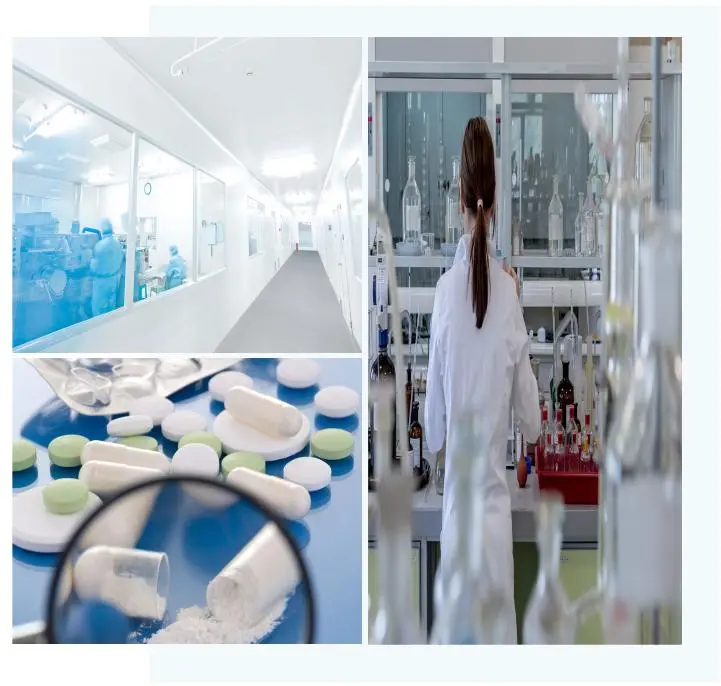Contact now:info@jameschem.com
Initiators for organic and pharmaceutical synthesis
James Chem promotes good health and well-being through material innovation and collaboration.
James Chem promotes good health and well-being through material innovation and collaboration.
 |
|
Magic Material Promotes Health and Well-being
• Clay has widespread applications in pharmaceuticals from the ancient world to the modern era. Some clay minerals have been known to possess antibacterial characteristics and can effectively treat wounds, soothe irritated skin, and stop bleeding in ancient times. Since it has unique physicochemical properties, it can play as both an active agent and a pharmaceutical excipient. As excipients, clays are vital in enhancing the quality and performance of pharmaceutical formulations, such as suspension or emulsion stabilizers, thickening agents, binders, disintegrants, fluidity-enhancing agents, wetting agents, and drug carriers. It also improves the technological and biopharmaceutical aspects of medicinal products. As active agents, clays are used to delay and/or target drug release or even improve the availability of active pharmaceutical ingredients. Furthermore, the structure of smectite clays allows for several routes to drug-clay interaction, such as adsorption by solvent deposition onto the high surface area of the clay to improve poorly soluble drugs dissolution. |
James Chem Synthetic Clay Material for Pharmaceutical-Magnesium Aluminum Silicate
• Magnesium aluminum silicate typical incorporated at levels ranging between 0.5% and 3% in formulations, is a common practice due to its ability to act as a stabilizer, suspending agent, rheology modifier, and adsorbent, improving product consistency, preventing ingredient separation, controlling viscosity, and enhancing skin feel in pharmaceutical and cosmetic products.
|
Effective thickening agent and viscosity modifier:
• It helps to improve the texture and consistency of formulations, providing a smooth and luxurious feel. Modifying the viscosity of the paste enhances the ease and accuracy of topical application, facilitating better patient outcomes. Magnesium aluminum silicate, by leveraging advancements in formulation science, has already developed high-performance topical treatment products that meet consumer needs. |
|
|
 |
|
Absorbent:
• Magnesium aluminometasilicate is an effective liquid adsorbent due to its practical shape. The high surface area of magnesium aluminometasilicate allows for equal adsorption of oil and liquid while maintaining good flow properties. Absorbing liquids, it prevents powder and granular materials from clumping together and helps other ingredients to apply more smoothly. |
|
Solubility enhancer:
• Poorly water-soluble drugs can be improved by dispersing them on magnesium aluminometasilicate. To improve fast dissolution and bioavailability, prepare a nanometric solid dispersion with solubility in the 200-400 nm range, which promotes rapid desorption of the poorly water-soluble pharmacological molecule. |
|
|
 |
|
Stability modifier:
• Magnesium aluminometasilicate is inert and harmless, which will not be destroyed or decomposed by bacteria and shear heating, will not be corroded by microorganisms, and will not deteriorate or mold because of long-term storage. Thus, certain findings indicate that magnesium aluminometasilicate helps to avoid drug desorption into packaging materials. This reduces the interaction between the medicine and the packaging materials, improving the stability of the drug substance. |
|
James Chem Potassium Monopersulfate Compound in Organic and Pharmaceutical Synthesis |
• Potassium Monopersulfate compound is also used in organic synthesis, such as oxidizing the double bonds of organic molecules, or as an initiator in many radical polymerizations. It has been applied to oxidize some pharmaceutical model compounds (antipyrine, acetaminophen, doxycycline, ketorolac, and caffeine) in aqueous solution.
 |
|
One example is the catalytic synthesis of menadione by potassium monopersulfate.
• Vitamin K3, also known as Menadione, is a synthetic form of Vitamin K that is used as a supplement. Unlike Vitamin K1 and Vitamin K2, high doses of Vitamin K3 can cause toxicity, so it is commonly used in livestock and pet feed. Many animals can also convert vitamin K3 to active forms of vitamin K, which is an important nutrient for all animals. The use of Vitamin K3 in humans is very controversial due to its potential adverse effects. People commonly use vitamin K for blood coagulation, so that injuries can heal. |
|
• The scientists carried out the oxidation of 2-methylnaphthalene by potassium monopersulfate in the presence of metalloporphyrin catalyst, producing mainly two napthoquinones, which are vitamin K3(2-methyl-1, 4-naphthoquinone) and 6-methyl-1, 4-naphthoquinone. Furthermore, Vitamin K3 and its homologs constitute a class of biologically active quinones as well as precursors in the synthesis of the vitamin K series. |
|
|
*James Chem actively collaborates with upstream and downstream customers, universities, and research institutes. To deliver a sustainable future for the world through our expertise in peroxide and materials science, we call for any current or potential partners, such as customers, suppliers, communities, universities, and government to collaborate with us. Please find James Chem domain experts for more details.
|
James Chem,Your Trusted Partner
We not only have standardized products but also provide a one-on-one customized solution. No matter what challenges we meet, we solve them together. Should you have any questions or needs related to initiators for organic and pharmaceutical synthesis, please do not hesitate to contact our service consultant. |
|
|
Related Products
 |
 |
||
| Potassium Monopersulfate Compound | Magnesium Aluminosilicate | ||
Magic Material Promotes Health and Well-being
• Clay has widespread applications in pharmaceuticals from the ancient world to the modern era. Some clay minerals have been known to possess antibacterial characteristics and can effectively treat wounds, soothe irritated skin, and stop bleeding in ancient times. Since it has unique physicochemical properties, it can play as both an active agent and a pharmaceutical excipient. As excipients, clays are vital in enhancing the quality and performance of pharmaceutical formulations, such as suspension or emulsion stabilizers, thickening agents, binders, disintegrants, fluidity-enhancing agents, wetting agents, and drug carriers. It also improves the technological and biopharmaceutical aspects of medicinal products. As active agents, clays are used to delay and/or target drug release or even improve the availability of active pharmaceutical ingredients. Furthermore, the structure of smectite clays allows for several routes to drug-clay interaction, such as adsorption by solvent deposition onto the high surface area of the clay to improve poorly soluble drugs dissolution.

James Chem Synthetic Clay Material for Pharmaceutical-Magnesium Aluminum Silicate
• Magnesium aluminum silicate typical incorporated at levels ranging between 0.5% and 3% in formulations, is a common practice due to its ability to act as a stabilizer, suspending agent, rheology modifier, and adsorbent, improving product consistency, preventing ingredient separation, controlling viscosity, and enhancing skin feel in pharmaceutical and cosmetic products.

Effective thickening agent and viscosity modifier:
• It helps to improve the texture and consistency of formulations, providing a smooth and luxurious feel. Modifying the viscosity of the paste enhances the ease and accuracy of topical application, facilitating better patient outcomes. Magnesium aluminum silicate, by leveraging advancements in formulation science, has already developed high-performance topical treatment products that meet consumer needs.

Absorbent:
• Magnesium aluminometasilicate is an effective liquid adsorbent due to its practical shape. The high surface area of magnesium aluminometasilicate allows for equal adsorption of oil and liquid while maintaining good flow properties. Absorbing liquids, it prevents powder and granular materials from clumping together and helps other ingredients to apply more smoothly.

Solubility enhancer:
• Poorly water-soluble drugs can be improved by dispersing them on magnesium aluminometasilicate. To improve fast dissolution and bioavailability, prepare a nanometric solid dispersion with solubility in the 200-400 nm range, which promotes rapid desorption of the poorly water-soluble pharmacological molecule.

Stability modifier:
• Magnesium aluminometasilicate is inert and harmless, which will not be destroyed or decomposed by bacteria and shear heating, will not be corroded by microorganisms, and will not deteriorate or mold because of long-term storage. Thus, certain findings indicate that magnesium aluminometasilicate helps to avoid drug desorption into packaging materials. This reduces the interaction between the medicine and the packaging materials, improving the stability of the drug substance.
|
James Chem Potassium Monopersulfate Compound in Organic and Pharmaceutical Synthesis
|
• Potassium Monopersulfate compound is also used in organic synthesis, such as oxidizing the double bonds of organic molecules, or as an initiator in many radical polymerizations. It has been applied to oxidize some pharmaceutical model compounds (antipyrine, acetaminophen, doxycycline, ketorolac, and caffeine) in aqueous solution.

One example is the catalytic synthesis of menadione by potassium monopersulfate.
• Vitamin K3, also known as Menadione, is a synthetic form of Vitamin K that is used as a supplement. Unlike Vitamin K1 and Vitamin K2, high doses of Vitamin K3 can cause toxicity, so it is commonly used in livestock and pet feed. Many animals can also convert vitamin K3 to active forms of vitamin K, which is an important nutrient for all animals. The use of Vitamin K3 in humans is very controversial due to its potential adverse effects. People commonly use vitamin K for blood coagulation, so that injuries can heal.

• The scientists carried out the oxidation of 2-methylnaphthalene by potassium monopersulfate in the presence of metalloporphyrin catalyst, producing mainly two napthoquinones, which are vitamin K3(2-methyl-1, 4-naphthoquinone) and 6-methyl-1, 4-naphthoquinone. Furthermore, Vitamin K3 and its homologs constitute a class of biologically active quinones as well as precursors in the synthesis of the vitamin K series.
*James Chem actively collaborates with upstream and downstream customers, universities, and research institutes. To deliver a sustainable future for the world through our expertise in peroxide and materials science, we call for any current or potential partners, such as customers, suppliers, communities, universities, and government to collaborate with us. Please find James Chem domain experts for more details.
James Chem,Your Trusted Partner
We not only have standardized products but also provide a one-on-one customized solution. No matter what challenges we meet, we solve them together. Should you have any questions or needs related to initiators for organic and pharmaceutical synthesis, please do not hesitate to contact our service consultant.

Related Products
Potassium Monopersulfate Compound
Magnesium Aluminosilicate
